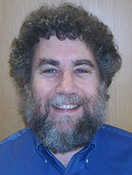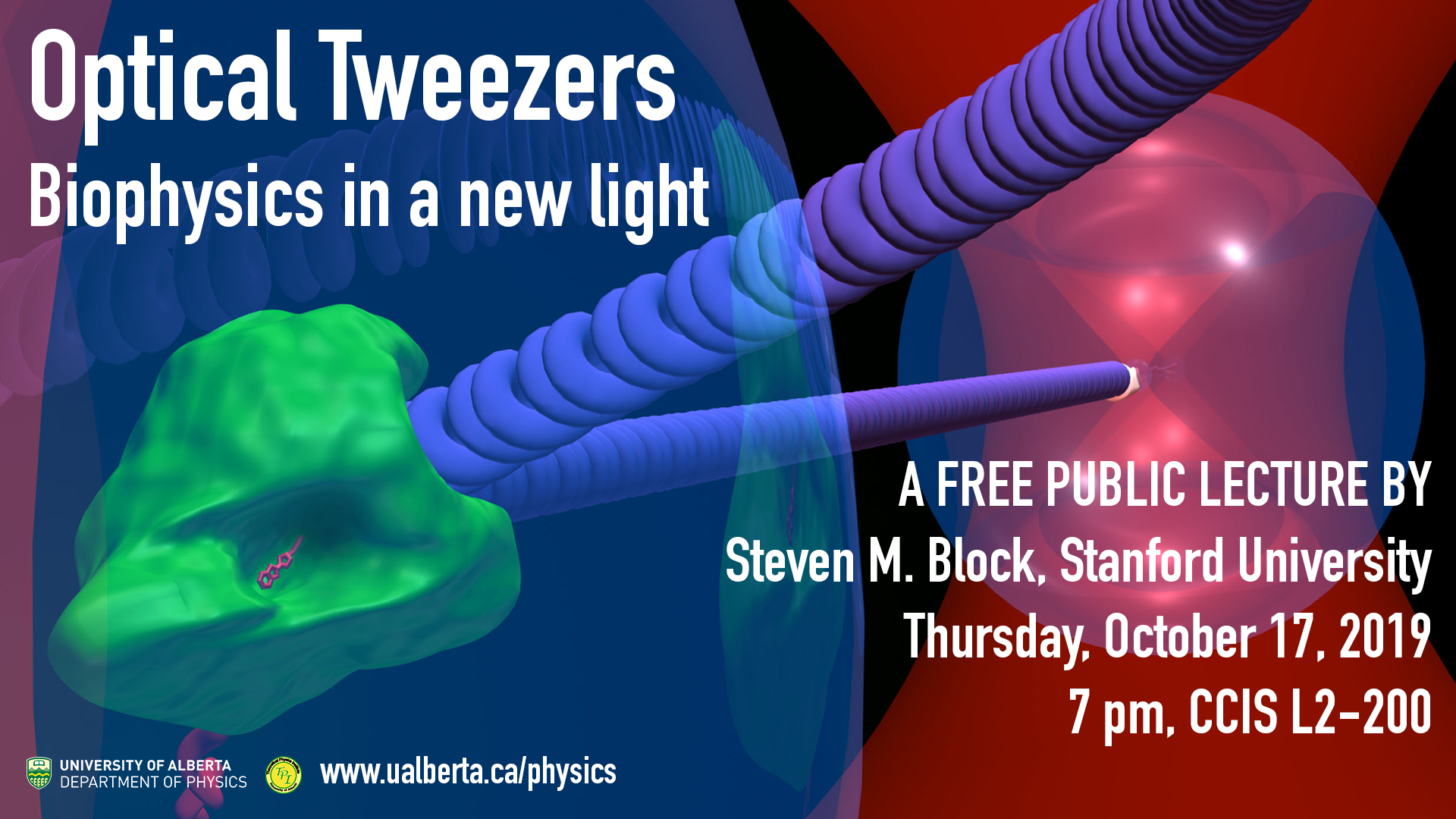TPI Seminars
Recordings
Visit the University of Alberta's Theoretical Physics Institute YouTube channel to view TPI talks.
Calendar
Past Events and Seminars
|
|
Steven M. Block
|
PUBLIC LECTURE
Thursday, October 17, 2019
7 pm, CCIS L2-200
Optical Tweezers: Biophysics in a New Light
Laser-based optical tweezers represent the closest thing to a tractor beam that humans have achieved, and the Nobel Prize in Physics for 2018 was awarded to Arthur Ashkin for their invention. Unlike the tractor beams of sci-fi fantasies, optical tweezers work in the realm of the microscopic. This talk will describe how optical tweezers can be used to manipulate objects as small as single biomolecules, and how they have advanced our current understanding of biophysics.
This talk is the 2019 Hiroomi Umezawa Memorial Public Lecture. Admission is free and open to the public.
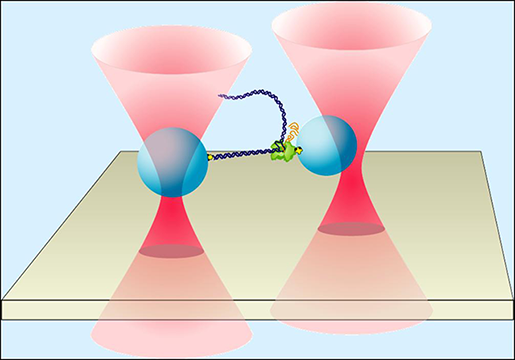
PHYSICS COLLOQUIUM
Friday, October 18, 2019
3 pm, CCIS L1-160
Optical Tweezers: Gene Regulation, Studied One Molecule at a Time
Single-molecule techniques record characteristics that are obscured by traditional biochemical approaches, revealing the behaviors of individual biomolecules. Prominent among single molecule techniques is the laser-based optical trap, or 'optical tweezers,' which relies on radiation pressure to manipulate tiny objects. Optical traps can measure biomolecular properties with a precision down the atomic level-achieving a resolution of 1 angstrom over a bandwidth of 100 Hz-while exerting controlled forces in the piconewton range. Among the successes of optical traps have been measurements of the molecular steps made by motor proteins (for example, kinesin and myosin) and by processive nucleic-acid enzymes (for example, RNA polymerase), determinations of the strengths of noncovalent bonds, and studies of the energetics and kinetics of structure formation in proteins and nucleic acids. Optical trapping instruments have been particularly useful in mapping the energy landscapes of folding for structured RNAs. We're now able to follow the co-transcriptional folding of RNA in real time, revealing how folding can regulate downstream genes, mediated by elements called riboswitches. In recent developments, optical traps are being used in conjunction with single-molecule FRET (Förster Resonance Energy Transfer) to report simultaneously on the folding configurations and internal degrees of freedom of riboswitches.
Steven M. Block is the S.W. Ascherman Professor of Sciences in the Departments of Applied Physics and of Biology at Stanford University. He received his B.A. and M.A. from Oxford University and his Ph.D. from Caltech. Block has been elected to the National Academy of Sciences and the American Academy of Arts and Sciences. He is a Fellow of the American Physical Society, a Fellow of the Biophysical Society, and a Fellow of the American Association for the Advancement of Science. He was awarded the Delbrück Prize in Biological Physics of the APS and the Founders Award of the BPS, among other academic recognitions. Block's research lies at the interface of physics and biology, particularly in the study of enzymes and nucleic acids at the single-molecule level. His group pioneered the development of the laser-based optical trap ("optical tweezers") to study biomolecules, and was the first to measure the fundamental steps taken by motor proteins, including the 8.2-nm steps of kinesin, a cellular transporter, and the 3.4-angstrom (basepair) steps of RNA polymerase, the enzyme responsible for transcription. His current research focuses on understanding the biomolecular mechanisms responsible for movement, fidelity, folding, and ligand binding.
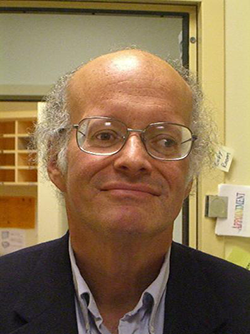
Patrick H. Diamond
University of California, San Diego
Tuesday, May 9, 2017, 3:15 pm
CCIS L1-160
Pattern formation in magnetically confined plasmas: why it matters
This colloquium will discuss the physics of turbulent transport in magnetic confinement devices, such as tokamaks, with special emphasis on scale selection and its consequences. Using analogies with turbulent pipe flow and geophysical fluids, the basic physics of magnetized plasma turbulent transport is developed. Then, the two principle secondary patterns-avalanches and zonal shear flows-are introduced. Scale selection is linked to the natural competition between these two structures. We present the ExB staircase as the natural resolution to the competition, and discuss recent work on the bstaircase and layering dynamics. Throughout , we discuss the implications of the physics for achieving ignition in a magnetically confined plasma.
This talk is the 2017 Hiroomi Umezawa Memorial Lecture.
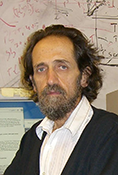
Prof. Jorge E. Hirsch
University of California, San Diego
Friday, October 28, 2016, 3 pm CCIS L1-160
Meissner effect in superconductors: an unrecognized puzzle
Superconductivity, the flow of electric current with zero resistance in certain metals at low temperatures, was discovered in 1911 by Kammerlingh Onnes. It took another 22 years for Meissner and Ochsenfeld to discover the telltale property of superconductors that makes them different from "perfect conductors": the spontaneous expulsion of magnetic fields from the interior of a metal becoming superconducting. This "Meissner effect" is generally believed to be explained by the conventional BCS-London theory of superconductivity developed in 1957. Instead, I argue that the Meissner effect is an unrecognized anomaly, an observation that cannot possibly be explained within the established paradigm and requires a paradigm shift [1]. I point out that conventional BCS-London theory violates Faraday's law, Lenz's law, Newton's laws and the second law of thermodynamics in its description of both the Meissner effect and the superconductor to normal transition in a magnetic field. I argue that to explain the observed phenomena in a way that respects these fundamental laws requires charge flow in direction perpendicular to the normal-superconductor phase boundary, and requires that the normal state charge carriers have hole-like character. The conventional theory of superconductivity does not possess these physical elements. Instead, the alternative theory of hole superconductivity [2], proposed in 1989 to explain high Tc superconductivity in cuprates and superconductivity in general, does. The empirically observed unexplained correlation between superconductivity and Hall coefficient [3] supports our point of view.
[1] T. S. Kuhn, "The Structure of Scientific Revolutions", University of Chicago Press, 1962.
[2] References in http://physics.ucsd.edu/~jorge/hole.html
[3] I.M. Chapnik, "On the empirical correlation between the superconducting Tc and the Hall coefficient", Phys. Lett. A 72, 255 (1979). Hosts: R. Sydora and F. Marsiglio
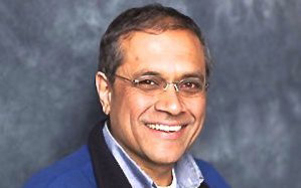
Professor Manu Paranjape
Groupe de physique des particules
Université de Montréal
Friday, September 16, 2016
11 am, CCIS 4-196
Three Explorations of Gravity in the Lab
We analyze three ideas for the study of gravity in interaction with matter, which give rise to a method of measuring the speed of gravity, a method of gravitationally inducing quantum transitions and the possibility of devising a graviton laser.
